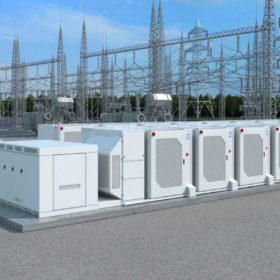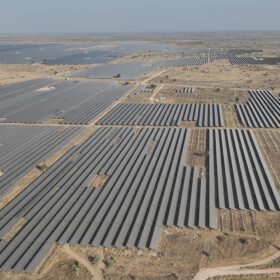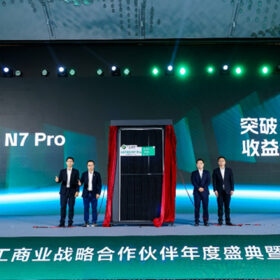Top News
SECI concludes 1.2 GW solar plus 600 MW/3,600 MWh storage tender at INR 3.12/kWh

Power Mech awarded 2 GWh battery storage project in West Bengal

India’s solar capacity additions on track: SBICAPS
SunRise Arabia Clean Energy Conference 2026
Join the 3rd SunRise Arabia Clean Energy Conference on April 22, 2026, in Riyadh to explore how solar PV and energy storage are powering the Kingdom’s growing digital economy — including data centers. Secure your spot at the early-bird rate.
Battery Business & Development Forum 2026
Connect with Europe’s energy storage leaders at the Battery Business & Development Forum 2026 in Frankfurt (March 31–April 1) and gain insights into evolving business models, financing strategies, and market trends
Out now - pv magazine Global Winter Edition
The new pv magazine Global edition is out now!
Available in print and digital – get your copy today!

Astronergy launches 670 W TOPCon solar module with 24.8% efficiency

SECI tenders balance-of-system package for 700 MW AC solar project in Gujarat
Saudi Arabia reveals qualified bidders for 3.1 GW solar auction
LEAPTING to deploy 2,000 G1 cleaning robots across Waaree Renewables’ 1.2 GWp solar projects
TOYO secures US polysilicon to navigate solar trade barriers
Markets & Policy
Featured
N-type wafer prices rise over 10% as silver-driven cell costs increase
The role of domestic manufacturing in India’s power security
India’s power landscape is undergoing a structural inflection point where domestic manufacturing has shifted from a supporting function to a central pillar of national energy security.
Inox Clean Energy raises INR 3,100 crore to expand renewable energy and solar manufacturing capacity
Inox Clean Energy Ltd has raised around INR 3,100 crore through an equity round involving the company and its subsidiary, Inox Solar Ltd. The company said the equity infusion will support its plans to achieve 10 GW of installed IPP capacity and 11 GW of integrated solar module manufacturing capacity by FY28.
India’s smart metering boom: How decentralized IoT is reinventing the power grid
The Indian power system is evolving faster than most global peers. Electricity demand is rising. Rooftop solar, electric mobility, and distributed generation are accelerating. The grid, once designed for predictable one-direction flows, is becoming a dynamic, decentralised organism. To manage it, India requires data that is just as distributed as the energy sources feeding the system. This is where decentralised RF mesh networks have begun to play an important role.
Google acquires Intersect Power for nearly $5 billion
Google is set to acquire solar and storage developer Intersect Power, arming itself with the tools to bypass grid bottlenecks and build the projects that will power its AI data centers.
China strengthens intellectual property protection in solar industry
Chinese authorities are planning to implement a series of policy measures to introduce stronger intellectual property protection to the country’s photovoltaic sector. Chinese enterprises are being encouraged to accelerate technological advancements and reserve basic patents for developing technologies.
Installations
Featured
Clean-tech startups are quietly turning India’s air pollution crisis into a renewables opportunity
Hartek secures INR 353.77 crore solar and battery storage EPC project in Karnataka
Hartek Power has secured an engineering, procurement and construction (EPC) contract worth approximately INR 353.77 crore for a 280 MW AC (410 MWp DC) solar PV power plant integrated with an 80 MW/320 MWh battery energy storage system (BESS) in Karnataka.
Axis Energy proposes INR 31,750 crore renewable energy investment in Odisha
Axis Energy plans to develop a diversified portfolio of nearly 5 GW of clean energy capacity across wind, solar, agri-photovoltaic (agri-PV), hybrid projects, and battery energy storage systems (BESS) with an investment of INR 31,750 crore.
Adani Green Energy arm signs agreements to supply solar-wind hybrid power to Asahi India Glass
Adani Green Energy Twenty Five B Ltd, a wholly owned step-down subsidiary of Adani Green Energy Ltd (AGEL), has entered into key agreements for the supply of 20.8 MW of solar-wind hybrid power to Asahi India Glass Ltd (AIS). The power will be supplied from a 25 MW solar power plant unit and a 20.8 MW wind power plant unit, both located at Khavda, Gujarat.
L&T commissions 185 MW solar plus 254 MWh battery storage project in Bihar
L&T Construction has commissioned 185 MW of grid-connected solar capacity coupled with a 254 MWh battery energy storage system at Kajra in Bihar’s Lakhisarai district, marking India’s largest commissioned solar-plus-BESS project to date.
Bondada Engineering commissions 120.46 MWp of solar capacity
Bondada Engineering Ltd has commissioned 120.46 MWp of solar power capacity in December 2025 for clients including Paradigm IT, Maharashtra State Power Generation Co. Ltd (MAHAGENCO), and NLC India Ltd.
Technology
Featured
The real question for India: Should we chase the next technology or optimize global best practices?
Aiko achieves 34.76% efficiency for 2-terminal perovskite-silicon tandem solar cell
The Chinese manufacturer said its 2-terminal 34.76%-efficient perovskite-silicon tandem lab-scale cell is based on heterojunction technology and developed by a collaboration of Solarlab Aiko Europe, Aiko headquarters, and its R&D in Yuwi, China.
The Hydrogen Stream: IIT Kanpur, HBTU to jointly establish Centre of Excellence for Green Hydrogen in Uttar Pradesh
The Centre of Excellence, operated from the campus of IIT Kanpur and HBTU Kanpur, will prioritize research and development focused on green hydrogen production, storage, transportation, safety standards, testing, demonstrations, and industrial use. Special emphasis will be on applied research and technological solutions for industries such as refineries, fertilizers, transportation, manufacturing, and energy systems.
The future of impact funding: Aligning capital with sustainable outcomes
The largest area of green financing is energy-efficient machinery, which supports MSMEs in modernising production lines and reducing operational energy consumption. Significant capital is also being channelled into rooftop solar installations, electric vehicles, and enterprises operating in the water, sanitation, and hygiene (WASH) sectors, across clusters such as manufacturing, healthcare, and food processing.
Solex Energy partners with Malaysia’s TT Vision on solar manufacturing automation and talent development
Solex Energy Ltd has signed a non-binding Memorandum of Understanding (MoU) with Malaysia-based automation technology company TT Vision Holdings Berhad to collaborate on advancing solar manufacturing automation, engineering excellence, and talent development in India.
MIT-WPU researchers develop safer liquid hydrogen transport system
Researchers at India’s MIT World Peace University (MIT-WPU) have developed a Liquid Organic Hydrogen Carrier (LOHC) system capable of transporting hydrogen in a stable liquid form that is non-flammable, non-explosive, and manageable at normal temperatures and pressures. This breakthrough removes one of the biggest barriers slowing the widespread adoption of hydrogen in India.
Manufacturing
Featured
India surpasses 144 GW of solar module capacity under ALMM
French startup offers on-site solar module repair solution
France-based DOTSun has developed an on-site repair solution for solar panels with degraded backsheets, compatible with PA, PVDF, and PET types. The system uses a compact laminator to apply a protective film to the rear side of the module, reportedly restoring insulation and extending the service life of up to 2,000 panels per site.
TP Solar reports 2.9 GW PV module and 2.8 GW cell output in 9M FY26
TP Solar Ltd, the solar manufacturing arm of Tata Power Renewable Energy Ltd (TPREL), produced 2.8 GW of solar cells and 2.9 GW of modules during the nine-month period ended Dec. 2025 (9M FY26).
Rising silver prices drive China’s Longi shift to copper-metallized solar cells
China’s Longi says it will begin mass production of base-metal PV modules in the second quarter of 2026 as rising silver prices intensify pressure to reduce metallization costs.
New process achieves 97% silver recovery from end-of-life solar panels
Australian researchers have developed a new separation technique that employs the same crushing and flotation principles used in mineral processing to recover more than 97% of silver from end-of-life solar panels.
Delta Electronics India to supply 110 MW of power conditioning systems for Prostarm’s battery storage projects
Delta Electronics India will supply 100 units of its made-in-India 1.1 MW bi-directional power conditioning systems to Prostarm’s battery energy storage projects for power utilities, including Bihar State Power Generation Company Ltd and Adani Electricity Mumbai Ltd.
Energy Storage
Featured
China connects world’s largest vanadium flow battery project
India’s energy storage market poised for breakout year: IESA
While 2025 was marked by an unprecedented 102 GWh of energy storage tenders, 2026 will see projects awarded since mid-2023 finally materialize into commissioned assets, in line with typical project timelines of 18–24 months.
NTPC REL invites bids for 250 MW solar project with 200 MWh battery storage in Uttar Pradesh
NTPC Renewable Energy Ltd has tendered the engineering, procurement and construction (EPC) package for the development of a 250 MW ground-mounted solar power project integrated with a 50 MW/200 MWh battery energy storage system (BESS) at Sitapur, Uttar Pradesh.
Waaree Energy Storage Solutions raises INR 1,003 crore for 20 GWh lithium-ion cell and battery pack manufacturing facility
Waaree Energy Storage Solutions has raised INR 1,003 crore to support the development of a 20 GWh lithium-ion cell and battery pack manufacturing facility.
India introduces ‘Battery Aadhaar’ system to track EV batteries across lifecycle
India’s Ministry of Road Transport and Highways (MoRTH) has released draft guidelines for the implementation of a Battery Pack Aadhaar system—an indigenous digital identification and data storage mechanism designed to ensure end-to-end lifecycle traceability of batteries, particularly those used in electric vehicles (EVs).
Bondada Engineering secures 225 MW/450 MWh standalone battery storage project from AP TRANSCO
Bondada Engineering Ltd has received a Letter of Award (LoA) from the Transmission Corp. of Andhra Pradesh Ltd (AP TRANSCO) for the development of a 225 MW/450 MWh standalone battery energy storage system (BESS) project.
Opinion & Analysis
Featured
India’s 2025 renewable energy sector review: Key highlights and way forward
Bridging the gap between India’s rare earth reserves and extraction challenges
While India has research capabilities across public laboratories and academic institutions in both rare earths and battery recycling, the transition from lab-scale innovation to industrial deployment has been slow. This gap between research and commercial execution continues to limit scale across the critical minerals ecosystem.
India’s energy transition has shifted gears decisively
India is moving decisively beyond capacity addition toward system-level maturity. Expanded transmission planning, a more diversified energy mix and better regulatory clarity signal a market design that is becoming ever more dynamic and future ready.
Global solar generation topped 540 GW in April, says Solcast
In a new weekly update for pv magazine, Solcast, a DNV company, reports that the global peak of solar output in 2025 occurred on April 29, at 06:00 UTC, estimated at 539 GW.
Top 5 trends shaping India’s battery energy storage systems market in 2025
India’s battery storage landscape is undergoing a decisive transformation in 2025. Across utilities, regulators, and developers, BESS has moved beyond early-stage exploration and is increasingly recognized as an essential component for grid stability, renewable integration, and long-term energy planning.
Why Tier-2 and Tier-3 cities will drive India’s next big solar jump
Tier-2 and Tier-3 cities are no longer behind in the solar journey, they are becoming the main growth drivers. With better government support, easier net-metering rules, and more awareness about savings, people in smaller cities are now ready for rooftop solar in a big way.





